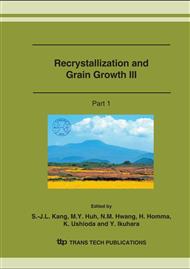p.787
p.793
p.797
p.803
p.811
p.817
p.821
p.827
p.835
Characteristic Microstructure and Grain Boundary Motion in Secondary Recrystallization of Fe-3%Si Alloys
Abstract:
The microstructure of Fe-3 mass% Si alloys before secondary recrystallization has been characterized by analyzing precipitates and grain boundary segregated elements. The samples used were mainly sheets of Fe-3%Si alloys containing manganese, sulfur, aluminum, nitrogen and tin, which were decarburized and annealed up to secondary recrystallization. Grain boundary segregation in primarily recrystallized samples was studied using Auger electron spectroscopy (AES), and precipitates were analyzed using transmission electron microscopy (TEM) with an energy dispersive X-ray spectrometer (EDX). AES spectra showed that tin and nitrogen were enriched on grain boundaries in the Fe-3 mass% Si alloys. TEM/EDX analysis showed that the morphology and distribution of the fine precipitates such as manganese sulfide and aluminum nitride were influenced by addition of tin. The characteristic structure formed by secondary recrystallization of grain oriented silicon steel is considered to be influenced by the fine precipitates and segregation of a small amount of elements, as the abnormal motion of grain boundaries of the silicon steel was correlated with the precipitation and segregation of the alloying elements.
Info:
Periodical:
Pages:
811-816
Citation:
Online since:
October 2007
Authors:
Price:
Сopyright:
© 2007 Trans Tech Publications Ltd. All Rights Reserved
Share:
Citation:


